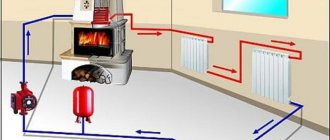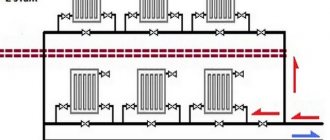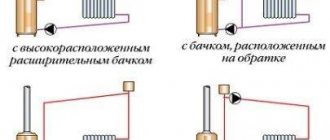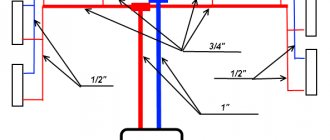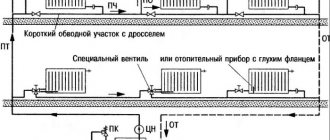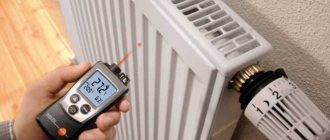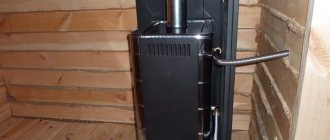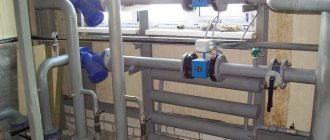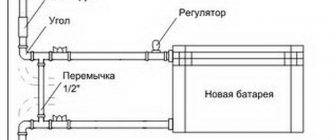Two-pipe heating system
The operating principle of a two-pipe heating system is somewhat different from that described above.
In this case, the coolant rises along the riser and is supplied to each heating radiator. And then it returns through the return line back into the pipeline, which transports it to the heating boiler. With this scheme, the radiator is served by two pipes - supply and return, which is why the system is called two-pipe.
What advantages does this arrangement provide?
Two-pipe main
What can you expect when choosing this option for organizing heating for a private and residential apartment building?
- Such a system allows you to organize uniform heating of each radiator. Any battery, no matter what floor it is on, receives hot water at the same temperature. If desired, you can install a thermostat on the radiator, and then the weather in the house can be independently adjusted. The use of a thermostat in a separate room does not affect the heat transfer of radiators installed in other apartments.
- In a two-pipe system, there are no large pressure losses during coolant circulation. Therefore, a powerful hydraulic pump is not needed for the normal functioning of the system. Water is able to circulate due to gravitational force, that is, by gravity. And if the water pressure is weak, it is enough to install a low-power pumping unit, which is more economical and easier to maintain.
- With the help of shut-off equipment, bypasses and valves, it is easy to organize such circuits that will allow you to repair, if necessary, one heating device without turning off the entire heating of the house.
- Another additional bonus of a two-pipe piping is the ability to use the associated and dead-end movement of hot water.
What is a passing scheme? This is when water both in the supply and return flows in the same direction. In a dead-end circuit, supply and return water circulates in opposite directions. When driving in parallel, provided that radiators of the same power are used, ideal hydraulic balancing is established. Therefore, there is no need to additionally use battery presetting valves.
If heating devices have different power, you will have to calculate the heat loss of each, carry out calculations and link the radiators using thermostatic valves. It is very difficult to do this yourself without knowledge and skills.
Note! Associated hydraulic gravity flow is used where long-distance pipelines are installed. For short systems, a dead-end coolant flow pattern is used
Classification of two-pipe heating system
Types of systems
The classification of two-pipe piping is made according to the location of the pipeline and the method of arranging the distribution system.
According to the location of the pipeline, it is divided into vertical and horizontal. In a vertical scheme, all batteries are connected to a vertical riser. This option is most often used in apartment buildings. The main advantage of this connection is the absence of air locks.
For a private house with a large area, experts recommend choosing horizontal two-pipe wiring and installing a Mayevsky tap in each radiator. It is needed to bleed air, and an example of its correct installation has been described in detail more than once in previous articles.
According to the wiring method, a two-pipe system can have lower and upper piping. In this case, the hot water supply riser is placed in the basement or basement. The return line is located here, but is installed below the supply. All radiators are located at the top. An upper air line is connected to the common circuit, allowing excess air to be removed from the system.
When installing the top trim, the entire distribution line is mounted in the insulated attic of the building. An expansion tank is also installed there. This scheme cannot be used if there is a flat roof.
Disadvantages of a two-pipe system
Dual-circuit system
Comparing two battery wiring schemes, it is easy to conclude which is better. The two-pipe one is in any case much more efficient. But it has one significant drawback. Its assembly will require twice as many pipes. In addition, they come with a large number of fasteners, valves and fittings, so installation of a two-pipe system is much more expensive.
Until recently, when steel pipes and labor-intensive welding processes were used to assemble a two-pipe piping, the cost was prohibitive. With the advent of metal-plastic and hot soldering technology, laying a two-pipe main has become accessible to almost everyone.
Which system to choose
To summarize, we can conclude that for small one-story buildings a single-pipe heating system is quite sufficient. This will ensure more or less uniform heating and save a lot of time and money during construction.
For large buildings consisting of a large number of rooms or several floors, it would be right not to save, but to prefer an energy-efficient (albeit definitely more expensive and cumbersome) two-pipe heating system.
However, with the advent of metal-plastic and PVC pipes, when the pipes themselves became relatively inexpensive, and the installation process was easy and simple, the issue of saving faded into the background, and the choice in favor of more efficient two-pipe heating systems became obvious.
We recommend that you read: Using uPVC pipes in pressure systems
Options for heating system schemes
The main criterion for separating all heating devices is the type of fuel. In addition, there are universal boilers that operate on several types of fuel, which allows you to save on electricity consumption. We suggest that you familiarize yourself with the existing connection diagrams for various heating equipment.
- Single-pipe. It is a simple option for laying a coolant line in a private and multi-storey building, as well as in an industrial enterprise. It is used in cases where it is necessary to lay a pipeline quickly and with minimal financial investment. The only caveat is that the length of the pipeline throughout the house is limited to 30 m. There are three types of single-pipe connection schemes: horizontal, vertical and “Leningradka”. They differ from each other in the way the coolant is supplied and removed to the batteries.
- Two-pipe. The batteries are connected to the supply and return lines. This way the heat distribution throughout the building occurs more evenly. Water arrives to each heat exchanger at approximately the same temperature. A similar scheme is mainly used in multi-storey buildings with a large number of heated rooms. There are options for bottom and top connection.
- Radial. From two common collectors for the floor, two pipes go to each of the radiators. The collectors themselves are connected to common boiler equipment. With this scheme, you can connect not only batteries to the heating, but also a “warm floor”. The installation of the beam system must be carried out at the stage of building a house, since it will be extremely difficult to introduce it into an already finished building.
Which heating system is better
? Which is better: a single-pipe or two-pipe heating system, each user decides for himself. The choice depends on the type of housing and financial capabilities.
In addition, there is heating with natural and forced circulation. In the first case, water passes through the circuit under natural forces, in the second, thanks to the operation of a circulation pump.
Single pipe heating system
It works on the principle: through one main pipe (riser), the coolant rises to the top floor of the house (in the case of a multi-story building); All heating devices are connected in series to the downward line. In this case, all upper floors will be heated more intensely than the lower ones. A well-common practice in Soviet-built multi-story buildings, when it is very hot on the upper floors and cold on the lower floors. Private houses most often have 2-3 floors, so single-pipe heating does not threaten a large temperature contrast on different floors. In a one-story building, heating is almost uniform.
The advantages of a single-pipe heating system:
hydrodynamic stability, ease of design and installation, low costs of materials and funds, since the installation of only one coolant line is required. Increased water pressure will ensure normal natural circulation. The use of antifreeze increases the efficiency of the system. And, although this is not the best example of a heating system, it has become very widespread in our country due to the high savings in material.
Disadvantages of a single-pipe heating system:
complex thermal and hydraulic calculations of the network; — it is difficult to eliminate errors in the calculations of heating devices; — interdependence of the operation of all network elements; — high hydrodynamic resistance; — limited number of heating devices on one riser; — inability to regulate the flow of coolant into individual heating devices; - high heat loss.
Improvement of single-pipe heating systems
A technical solution has been developed that allows you to regulate the operation of individual heating devices connected to one pipe. Special closing sections - bypasses - are connected to the network. The bypass is a jumper in the form of a piece of pipe that connects the direct pipe of the heating radiator and the return pipe. It is equipped with taps or valves. The bypass makes it possible to connect automatic thermostats to the radiator. This allows you to regulate the temperature of each battery and, if necessary, shut off the coolant supply to any individual heating device. Thanks to this, it is possible to repair and replace individual devices without completely shutting down the entire heating system. Correctly connecting the bypass makes it possible to redirect the flow of coolant through the riser, bypassing the element being replaced or repaired. For high-quality installation of such devices, it is better to invite a specialist.
Vertical and horizontal riser diagram
According to the installation diagram, single-pipe heating can be horizontal or vertical. A vertical riser is the connection of all heating devices in series from top to bottom. If the batteries are connected in series to each other throughout the entire floor, this is a horizontal riser. The disadvantage of both connections is air pockets that occur in heating radiators and pipes due to accumulated air.
A heating system with one main riser is equipped with heating devices that have improved reliability characteristics. All devices in a single-pipe system are designed for high temperatures and must withstand high pressure.
Installation technology of a single-pipe heating system
1. Installation of the boiler in the selected location. It is better to use the services of a specialist from the service center if the boiler is under warranty. 2. Installation of the main pipeline. If an improved system is being installed, then it is mandatory to install tees at the connection points of radiators and bypasses. For a heating system with natural circulation, when installing pipes, create a slope of 3 - 5° per meter of length, for a system with forced circulation of coolant - 1 cm per meter of length. 3. Installation of a circulation pump. The circulation pump is designed for temperatures up to 60°C, so it is installed in the part of the system where the temperature is lowest, that is, at the entrance of the return pipe to the boiler. The pump operates from the mains power supply. 4. Installation of the expansion tank. An open expansion tank is installed at the highest point of the system, a closed one - often next to the boiler. 5. Installation of radiators. They mark out places for installing radiators and secure them with brackets. At the same time, they comply with the recommendations of device manufacturers regarding maintaining distances from walls, window sills, and floors. 6. The radiators are connected according to the chosen scheme, installing Mayevsky valves (for venting the radiators), shut-off valves, and plugs. 7. The system is pressure tested (air or water is supplied to the system under pressure to check the quality of connection of all elements of the system). Only after this, coolant is poured into the heating system and a test run of the system is performed, and adjustment elements are adjusted.
For a one-story house
The simplest single-pipe heating scheme, which has been used by developers for more than half a century, is Leningradka.
The figure shows a sketch of a modernized version of the Leningradka, with diagonal connection of radiators. The following elements are indicated in the figure (from left to right):
- Heating installation. Boilers operating on solid fuel, gas (natural or liquefied) and electricity are suitable for the implementation of this CO. Theoretically, liquid fuel boilers are also suitable, but the problem of storing fuel in a private home arises.
- A safety group, which consists of a blast valve set to a certain pressure in the system, an automatic air vent and a pressure gauge.
- Radiators connected to the system through shut-off ball valves. Needle balancing valves are installed in the jumper between the inlet and outlet of each radiator.
- A membrane expansion tank is installed on the return branch of the pipeline to compensate for the thermal expansion of the coolant.
- A circulation pump that creates forced movement of coolant through CO.
Now about what is not yet indicated in this sketch, but is a mandatory element for the reliable operation of this circuit. Only the pump was mentioned above, but its piping was not indicated, which includes three ball shut-off valves, between which a coarse filter and a pump are installed. Quite often, a pumping group with piping is connected to the CO through a jumper, thereby forming a bypass.
Often, developers ask whether a bypass is needed in a single-pipe heating system? The thing is that this CO scheme is self-sufficient and efficient. But in the event of a power outage, the circulation pump will stop and the movement of the coolant will stop. A bypass is optional, but it is better to build it to switch from forced to natural coolant circulation in the event of an emergency.
As for the pipeline: since the temperature at the boiler outlet can reach 80°C, it is recommended to use reinforced polypropylene pipes of the required diameter for the Leningradka circuit. Why reinforced? The thing is that polymer pipes are quite cheap and practical, they are easy to install and have a small weight. But, polymer pipes change their length when heated. Reinforced polymer does not suffer from such a “disease”.
Advice: despite the fact that this version of the CO has an automatic air vent, cases of airing of the circuit do occur. To solve this problem, it is recommended to use Mayevsky taps on radiators.
Single-pipe and two-pipe heating systems - comparison and selection
Let's compare what you need to choose - a single-pipe heating system, the so-called Leningradka, or a two-pipe one. Which one is cheaper to create and which one is better in terms of performance.
What are the opinions, what do the experts say?
The single-pipe heating system has been used quite widely, it is efficient and many of its owners will say that in their opinion it works either well or satisfactorily. At the same time, upon first consideration, two-pipe systems look clearly more expensive, because two conductors are used instead of one. This, according to some, increases prices not only in terms of materials, but also during installation and clutters up the space.
But experts are more likely to point out that a two-pipe heating system for a private home is cheaper and works better, and you need to choose it. Why is that?
Serious disadvantages of a single-pipe heating system - temperature difference
In a one-pipe heating system, where all radiators are connected in series, the latter will be colder than the previous ones. But how much will the temperature decrease? And how will this affect comfort?
The temperature drop will depend on the amount of liquid passing through the ring main pipeline. The larger the diameter of the pipe and the higher the speed in it, the less will be the influence of each radiator. By increasing these parameters, we can achieve, for example, that on five batteries the temperature drop will be no more than 10%. But this is in theory.
In practice, we are limited by the reasonableness of the costs for the diameters of the pipes and their tees, as well as the choice of pump - choose the right low-power circulation pump and install it at first speed so that it consumes no more than 30 W of electricity.
In this case, in “Leningrad without madness,” we use a main pipe with a diameter of 26 mm for metal-plastic, or 32 mm (outer) for polypropylene, to connect four radiators in a ring. The radiator connections are 16 mm (20 mm polypropylene).
Then the power drop on each radiator will be about 7%. At the same time, the temperature will drop by about 4 degrees, and these are not the worst indicators.
Therefore, if the 1st radiator is 60 degrees, then at the entrance to the 4th we will already get +48 degrees C. In principle, the functionality of this circuit is maintained up to 4 heaters per ring. But 5 pcs. It can no longer be recommended - there is a significant loss of power and an increase in the costs of compensating for it by increasing the radiator itself.
And 8 pieces - etc. - completely ineffective temperature schemes that cannot provide comfort, since the temperature drop on a ring with an acceptable diameter and pump power (without creating water noise) will be completely critical - up to 32 - 36 degrees.
How to prevent the temperature from decreasing in Leningrad
- There is an opinion that you can install thermal heads on radiators, raise the temperature in the boiler and thus hope that the last radiator in a row of 8 pieces will someday heat up. In fact, this is completely wrong, if only for the reason that you have to wait - when it is already hot in the first room, then in the last there is still a glacier. It is also not correct to operate the boiler in high temperature mode, when it must often turn off - it has heated the rooms, turned off, then warmed up again...
- Another option to equalize the temperature in single-pipe radiators is to install additional balancing valves on the first radiators in order to turn them off and send more liquid to the last ones. The result is an expensive and difficult to customize system.
- Now the option recommended by experts is to increase the power of the radiators from what is required by calculation. The increase should be proportional to the cooling of the water. For 8 the battery is almost 100%. Expensive and cumbersome, but the heating power of rooms and the air temperature in them can be equalized.
Which is cheaper and more profitable - single-pipe or double-pipe?
A single-pipe not only entails setup difficulties, but it is also more expensive - only due to the increased diameter of the pipeline and its fittings.
Let's calculate how much the materials will cost for a typical heating scheme for a small house of about 110 sq. m. - the first floor is 60 sq. m., approximately 6x10 m, and the attic is 50 sq. m., 5x10 m. There are 4 units installed on each floor. radiators. A reasonable minimum pipe diameter for is 26 mm.
For a two-pipe scheme, 20 mm is suitable for both shoulders and risers, with such a small number of radiators. And we connect the second battery at the dead end already 16 mm.
Placing radiators around the perimeter of the house, 4 pcs. per floor, we get the following:
For a single-pipe we will need the following pipe lengths and diameters:
- 26 mm – 70 m.
- 16 mm – 5 m.
- Tees 26 mm – 18 pcs.
For a two-pipe we need
- 20 mm – 42 m
- 16 mm – 50 m
- Tees 20 mm – 14 pcs.
Then the difference in price only for a branded metal-plastic pipeline is about $200 - installation of a single-pipe will be more expensive. And if we add even a small increase in the power of the latest radiators (as recommended), then it’s already $250. True, if you use cheap polypropylene the difference in price will be small, but still Leningradka will be much more expensive than a modern heating system with supply and return.
Unacceptable but cheap scheme
What if you turn on the radiators according to the circuit without a ring pipe, but simply by connecting them in series? After all, then the price is minimum. But the cooling of the coolant will be very significant, and include more than 3 pieces. batteries are not worth it according to this scheme.
The maximum number of radiators is 4 pieces, but at the same time the power of the latter drops by 35 - 40%. Those. This scheme is also viable, it can be useful with 3 radiators in a ring. And with 4, there is a significant cost to increase its size and power, so it won’t be any cheaper.
Conventional dead-end two-pipe circuit, what are the advantages
The usual two-pipe dead-end circuit allows you to place 4 radiators in an arm, without balancing valves, and the temperature drop will be a maximum of 5% on the last radiator, which cannot even be detected without instruments. If you place 5 batteries, then without balancing with taps, the power output on the latter will drop to 15%, which is also acceptable.
The diameters of the pipes are as follows.
- A 26 mm line extends from the boiler, then in the shoulders to the penultimate radiator - 20 mm, and to the last radiator - 16 mm.
- Radiators are connected 16 mm.
- For polypropylene, the outer diameters are 32, 25, 20 mm, respectively.
As indicated, the cost of creating such a system is minimal; balancing is not required even between arms, if the dead ends are approximately equal in power and pipe length.
Where and when is single-pipe heating used?
Single-pipe systems were previously widely used in centralized systems, where large-diameter steel pipes were laid, and the pump was no joke. The systems are still in use and new ones are being designed, mainly at industrial enterprises where there are kilometers of pipes, and then the system becomes more profitable.
Also, the risers of high-rise buildings are the same heating systems with one pipe, where a central pump provides high pressure. But as soon as the temperature or pressure drops, which is not uncommon (due to lack of energy, in some places the valves are screwed on specially), the radiators on the 5th floor of the Khrushchev building become not at all comfortable, although on the 2nd it is still somehow acceptable, oh what the residents of such houses themselves can tell. This is a pronounced disadvantage of a single-pipe heating system.
As we see, it is possible to use Leningrad, it has the right to life, but only in very small systems, if for some reason only one pipeline needs to be laid, although in general it will cost more. The main choice should be a heating system with all radiators connected using two pipes.
Pros and cons of a single-pipe system
To begin with, let us recall that a single-pipe circuit represents one horizontal collector or vertical riser, common to several radiators connected to it by both connections. The coolant, circulating through the main pipe, partially flows into the batteries, gives off heat and returns back to the same collector. The next radiator receives a mixture of chilled and hot water with a temperature reduced by several degrees. And so on until the very last radiator.
The main difference between a one-pipe heating system and a two-pipe one, which gives it some advantage, is the absence of separation into supply and return pipelines. One main line instead of two means less pipes and work on their installation (punching walls and ceilings, fastening). In theory, the total cost should be lower, but this is not always the case. Below we will explain why.
Thanks to the advent of modern fittings, it has become possible to regulate the heat output of each radiator automatically. True, this requires special thermostats with a larger flow area. But even they will not rid the system of its main drawback - cooling of the coolant from battery to battery. As a result, the heat transfer of each subsequent device decreases and it is necessary to increase its power by increasing sections. And this is an increase in cost.
If the main line and the supply to the device are of the same diameter, then the flow will be divided approximately equally. This cannot be allowed; the coolant will cool down greatly in the very first radiator. In order for a third of the flow to get into it, the size of the common collector must be made twice as large, and around the entire perimeter. Imagine if this is a two-story house with an area of 100 m2 or more, where a DN25 or DN32 pipe is laid in a circle. This is the second price increase.
If in a one-story private house it is necessary to ensure natural circulation of water, then a single-pipe heating system differs from a two-pipe heating system by the presence of a vertical accelerating manifold with a height of at least 2 m, installed immediately after the boiler. An exception is pumping systems with a wall-mounted boiler suspended at the required height. This is the third price increase.
Features of single-pipe systems
In its simplest form, single-pipe wiring is called “Leningradka”. It's far from perfect, but it's popular because of its simplicity. Leningradka is a system in which all heating elements are connected in series to one pipe, which serves as both a supply and a return. It turns out that the line is looped (to the boiler with an individual heating system or to the riser with a centralized one), and radiators or other devices are connected to it in the right places in a gap or in parallel.
Single-pipe system in its simplest form
The coolant in the direction of movement sequentially enters each heating device. This is the main drawback. The first radiator receives the hottest coolant. Part of the heat is taken away to heat it. The coolant becomes colder and is mixed into the line, reducing the overall temperature. After which, slightly colder, it flows to the second radiator, where it cools down a little again and, being added to the main flow, cools it even more. As it progresses, increasingly cold coolant enters each subsequent heating element. If the chain is long enough and there are a large number of devices, the last radiator can be completely ineffective.
To get around this property and achieve approximately equal output from each device, you can increase the number of radiator sections as they move away from the boiler outlet. In this way, you can compensate the system (even out the heat transfer of each element). As an option to use disadvantages for good, you can consider this method: install the “hottest” heating devices in the coldest rooms (for example, on the north side) or in those where elevated temperatures are required - children’s rooms and bedrooms.
In order to be able to regulate the temperature, a bypass and taps are installed on the radiator
Some types of radiator connections allow you to install regulators and taps that can be used to regulate the intensity of coolant flow in each heating element, leveling the temperature if necessary. This allows you to achieve more or less equal heat transfer from each of them, but this is not always possible.
According to the wiring method, a single-pipe system can be horizontal or vertical.
Single pipe heating system
This option is used in cases where it is necessary to carry out communications quickly and at minimal cost.
It is used in residential, private and industrial construction. A special feature of this solution is the absence of a return water supply line. The batteries are connected in series, assembly is carried out in a short time and does not require complex preliminary calculations.
How does a single-pipe line work?
In such designs, the coolant is supplied to the top point and flows down, sequentially passing through the heating elements. When arranging a multi-storey building, it is practiced to install an intermediate pump, which creates the necessary pressure in the supply pipe to push hot water through a closed circuit.
Vertical and horizontal schemes
The construction of a single-pipe main is carried out in vertical and horizontal orientation. Vertical wiring is installed in buildings with two or more floors. The coolant is supplied to the radiators, starting from the top. Horizontal heating mains are most often used for equipping single-level buildings - houses, cottages, warehouses, offices and other commercial facilities.
The pipeline layout assumes a horizontal riser arrangement with its sequential supply to the batteries.
Advantages and disadvantages
The single-pipe version of the heating main design has the following advantages:
Installation is carried out quickly, which is important given the modern requirements of the pace of construction. In addition, the appearance of a single-pipe collector several meters high compares favorably with a complex system of two lines. Small budget. Cost calculations show that a minimum number of pipes, fittings and fittings are required for construction. If consumers are installed on bypass, then it becomes possible to regulate the heat balance separately in each room. The use of modern shut-off devices makes it possible to modernize and improve the highway
This allows you to replace radiators, insert devices, and other improvements without a long shutdown of the system and draining water from it.
This design also has its disadvantages:
- The sequential arrangement of the batteries does not exclude the possibility of adjusting the heating temperature in them individually. This entails cooling of all other radiators.
- Limited number of batteries per line. It is not advisable to place more than 10 of them, since at the lower levels the temperature will be below the permissible level.
- The need to install a pump. This event requires additional financial investment. The power plant can cause water hammer and damage to lines.
- In a private house, you will need to install an expansion tank with a valve to bleed air. And this requires a place and insulation measures.
Installation of a one-pipe system
Pipeline
installation - the advanced system requires the installation of tees where bypasses and radiators are connected.
If this is a system with natural circulation, you need to create a slope of 3-5 cm long per meter, and for forced circulation - 1 cm/m.
Installation of a circular pump - installed at the entrance of the return pipe to the boiler, since there is the lowest temperature.
Powered by power.
Installation of an expansion tank - a closed tank is usually installed next to the boiler. Open – at the highest point of the system.
Installation of radiators - radiators are secured using brackets and installed at the recommended distance from floors, walls and ceilings; markings are made for this.
The connection is made according to the diagram, using taps to vent the radiators, which close the taps and plugs.
Pressure testing of the system - after which coolant is poured into the battery and the system is directly adjusted.
What to consider when installing any system
Heating boiler operating diagram.
It is important not to forget to install regulating thermal valves at the inlet and outlet of the radiator, as well as a drain valve, which is usually located at the lowest point of the heating structure. Purchasing used or “cheap” pipes and fittings in any heating system can later result in very serious problems requiring major repairs not only of the entire heating structure, but also of the house itself due to the possible rupture of hot water pipes and its flooding
Purchasing used or “cheap” pipes and fittings in any heating system can later result in very serious problems requiring major repairs not only of the entire heating structure, but also of the house itself due to the possible rupture of hot water pipes and its flooding.
Two-pipe heating distribution is possible for a private house with any number of floors. And its operation can occur without the use of a circulation pump. But these systems have rather low efficiency and are no longer used by many people nowadays.
https://youtube.com/watch?v=IVHMLLJRL6M
When deciding to place a two-pipe distribution system with a collector in a house, you need to carefully consider and plan the placement of the coolant distribution unit, the so-called comb. It will be correct to make the length of the pipes extending from it commensurate, since a significant difference in length from the comb to the radiators can lead to a significant difference in pressure. And this will complicate the adjustment of the system as a whole. The best solution for placing the comb is such that there is approximately an equal distance from each of the radiators.
Pipes for heating installations can be copper, steel, polypropylene and metal-plastic, but in no case should they be galvanized. The required type of pipes is selected depending on the construction project and the preferred characteristics: economic, environmental. But hydraulic characteristics should be a priority.
The flow rate of the pipes required for laying this system will depend on the chosen heating distribution scheme (two-pipe or one-pipe). Private houses with a large area require the equipment of a two-pipe system, into which a circulation pump is also installed. Temperature control in each room is carried out using thermostats.
Advantages and disadvantages
The demand for a dual-circuit heating system is explained by the presence of a number of significant advantages. First of all, it is preferable to a single-circuit one, since in the latter the coolant loses a noticeable part of the heat even before it enters the radiators. In addition, the double-circuit design is more versatile and suitable for houses of different floors.
The disadvantage of a two-pipe system is its high price. However, many people mistakenly believe that the presence of 2 circuits requires the use of twice the number of pipes, and the cost of such a system is twice as much as a single-pipe system. The fact is that for a single-pipe design it is necessary to take pipes of large diameter. This ensures normal coolant circulation in the pipeline, and therefore the efficient operation of such a design. The advantage of a two-pipe system is that for its installation, pipes of smaller diameter are used, which are significantly cheaper. Accordingly, additional elements (pipes, valves, etc.) are also used with a smaller diameter, which also somewhat reduces the cost of the design.
The installation budget for a two-pipe system will not be much larger than for a single-pipe system. On the other hand, the efficiency of the first will be noticeably higher, which will be a good compensation.
Natural circulation system
The operating principle of this system is that the boiler heats the coolant, its density decreases with increasing temperature.
The cold coolant displaces the heated coolant upward, it moves through the system, giving off heat, and then, having gained density, returns back to the boiler, etc.
In this way, liquid is circulated through the system, accompanied by heating of the room, without a pump or other additional equipment.
An insignificant disadvantage is the small pressure drops in the system; this fact does not allow the system to be installed over a large radius.
From the moment the boiler is turned on until the temperature in the room is fixed, quite a lot of time passes and this is a kind of disadvantage.
Another disadvantage is the condition of inclined installation of pipes, which is simply necessary for the liquid to move in the required direction.
A significant advantage is the system’s ability to self-regulate - when the ambient temperature drops, the circulation rate increases.
In addition to temperature, the speed of fluid movement is influenced by the following factors: the radius of the pipes, the material from which they are made, their cross-section, the number of turns in the system, the presence of fittings and its type.
Heating two-pipe system
In this system, the coolant passes through the heater cycle to the radiators and back.
In such a system there are two pipelines: through the first, hot coolant is supplied and divided, and through the second, cooled liquid flows back into the boiler.
A system of two pipes is divided into horizontal and vertical.
The advantages of the vertical system are that no air pockets appear during operation, which, however, makes such a connection quite expensive. Using this system, you can connect each floor to an individual highway.
For large private houses, a horizontal heating system is often used. Here the batteries are connected to a horizontal pipeline.
Air plugs are removed using air vents. This heating system is also divided into systems with upper and lower wiring.
In a horizontal system with bottom wiring, the heated pipeline is located in the basement, and the return riser is located even lower.
In order to improve circulation, the boiler is installed below the level of the radiators, and in addition, a return riser is located below the boiler. In order to remove air from the network, the upper air line is included in the circuit.
In a heating system with overhead wiring, the upper piping runs in the attic if the building has a sloping roof.
The advantage of a heating system with two pipes is the installation of automatic heat supply thermostats, which provides full opportunity for temperature adjustments in individual rooms.
This also includes the independence of operation of circuit devices, which is ensured by a special collector system.
The difference between a two-pipe system and a single-pipe system is that the first can include additional batteries after connecting the key ones, and also the possibility of extension in horizontal and vertical directions.
Unlike the single-pipe system, possible errors can also be easily corrected here.
The disadvantages of this system are minimal if you have the required amount of financial resources and have the opportunity to call a specialist.
Installation of a heating system with a lower horizontal piping structure
This system allows you to place the open tank in a good warm place. Also, it is possible to connect the expansion and supply tanks, allowing you to use hot water directly from the heating system
.
In systems with forced circulation, to reduce pipe consumption, the outlet and supply risers are located at the level of the first.
- Corner connectors in the downward direction are installed on the boiler pipes.
Two branches of pipes are installed on the floor, under the walls. One branch is connected to the supply output of the boiler, and the rest to the receiving output.
Tees are installed under each heating device, connecting them with pipes. The extensive tank is mounted in the upper part of the supply pipe. A pump is connected to the inlet of the heating tank, and the free end of the outlet pipe is connected to the pump.
Installation of a heating system with an upper horizontal wiring structure
The disadvantages of such a system are that the extensive tank is placed outside a warm room on the ceiling.
- A corner connector is attached to the section of pipe coming out of the boiler in order to rotate the pipe upward.
- Using tees and angles, the upper branch is installed, and the tees are secured above the heating devices.
- The tees are soldered to the upper section of the pipe, and a shut-off valve is installed at the intersection point.
- After this, on the first floor, the lower branch of the outlet pipe is combined, which collects all the pipes coming from the lower batteries.
- The free end of the outlet pipe is installed in the bypass, which is installed in the receiving section of the pipe.
Comparable parameters
The following parameters will determine which heating system is better, single-pipe or double-pipe, and in what situations one or another system should be used.
Price
A single-pipe heating system is more expensive. The high cost consists of two main factors:
The need to increase the number of sections in each radiator next in the direction of coolant circulation. A single-pipe circuit consists of one supply pipeline through which the coolant passes through the entire heating circuit, sequentially entering each heating device. From each radiator, the coolant leaves several degrees colder than when entering the radiator (part of the heat, about 10°C, is transferred to the room). Therefore, if a coolant with a temperature of 60°C enters the first radiator, then a coolant with a temperature of 50°C leaves the radiator, after which the 2 flows are mixed in the supply line, as a result of which the coolant enters the second heating device with a temperature of about 55°C . Thus, after each radiator there will be a loss of about 5°C. It is to compensate for these losses that it is necessary to increase the number of sections for each subsequent heating device.
Which heating system is better: one-pipe or two-pipe? What is the difference?
In a two-pipe scheme, there is no need to increase the number of radiator sections, because Each device receives coolant at almost the same temperature. The two-pipe contains both a supply and a return line, to which each heating device is simultaneously connected. Having passed through the radiator, the coolant immediately enters the return line and is sent to the boiler for further heating. Thus, each radiator receives almost the same temperature (heat losses are present, but they are very insignificant).
Note! The best application of a single-pipe circuit is small heating systems where there are no more than 5 radiators. With such a number of heating devices, the coolant, sequentially passing through all 5 radiators, does not lose heat in such critical quantities as in single-pipe systems with a large number of heating devices.
The need to use an enlarged supply pipeline. If the supply pipeline is too “thin”, this will lead to the fact that many radiators simply do not receive the heated coolant. A large diameter pipe allows you to deliver heated coolant to as many heating devices as possible. The thicker the supply pipe, the fewer sections need to be added to each radiator.
Thus, an increase in the number of radiator sections and an increase in the diameter of the supply line makes a single-pipe system more expensive in comparison with a similar two-pipe system.
Economical
The two-pipe scheme is more economical to operate. As noted above, in order to achieve uniform heating of all radiators in a single-pipe circuit, it is necessary to use a “thick” supply, as well as an increase in the number of sections in the radiators. All this increases the volume of coolant, and the more coolant in the system, the more fuel is required to heat it. Therefore, to the question which heating system is better, one-pipe or two-pipe in terms of efficiency, the answer will be in favor of the two-pipe system.
Installation process
A single-pipe system is a more complex system to calculate, because it is necessary to correctly calculate how many sections should be increased for each subsequent heating device
In addition, special attention must be paid to the calculation of the supply line and radiator connections
Which heating system is better: single-pipe or two-pipe?
The main criterion for selection is the building, the number of its rooms, their sizes. With one-story houses of a small area, as a rule, the owners are quite capable of providing high-quality heating with single-pipe systems. In this case, heating will be relatively uniform, work will not take maximum time, and the costs of home improvement will not be catastrophic.
Substantial buildings with several floors and a large number of rooms require more advanced, energy-efficient design that works with pumps. Therefore, saving should not be at the forefront here, because the main thing in the house is comfort. Large expenses, no doubt, will soon pay off: the possibility of room-by-room temperature control using thermostats (thermal heads) makes two-pipe systems more economical.
The appearance on the market of inexpensive materials - metal-plastic and PVC pipes - may further tip the scales towards two-pipe heating. In addition to reducing the cost of construction, such pipes have another important advantage - simple, quick installation, so the advantage of two-pipe, more modern designs is already becoming obvious.
Which heating system is better: single-pipe or two-pipe? The owners of the building themselves must find the answer. The first scheme is simple, and its installation is relatively quick. The second design is more flexible and customizable, but it will require much more money to set up. However, before making your final choice, you need to take one “but” into account. If you install a heating system that is completely unsuitable for the home, then the owners will soon face a new large-scale operation - re-equipment, and this promises very serious expenses.
What experts think about this can be heard in this video:
